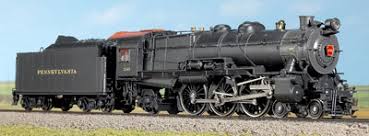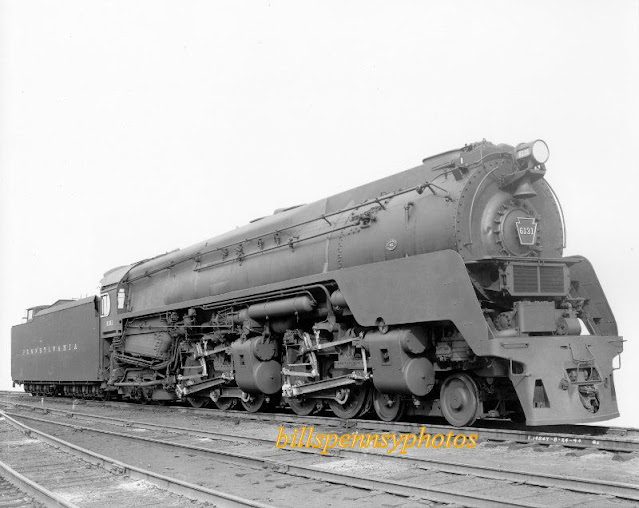 |
| PENNSYLVAIA RAILROAD CLASS T 1 |
Just as Australian, British and French Railways experienced the demands of heavier trains and the need for greater speed, the Americans did so too, only more so in some ways.
American Railroads were of course not Government-owned. They were all companies and often direct competitors. They were blessed with historically larger loading gauges and frequently heavier built permanent ways.In many cases the density of population made possible things that could not even be dreamed of in Australia for example.
One of the outstanding Railway companies in the United States was the Pennsylvania Railroad whose famed symbol was the red Keystone which was emblazoned an all its locomotives. It had a proud tradition of extraordinarily successful locomotive design. This went back to the turn of the Century.
The peak of development as the American Railroads came out of the early and the Civil War periods was the Atlantic type (4-4-2) Steam Locos. With their large driving wheels and ample fireboxes, they had boilers which could and did sustain very fast and relatively heavy passenger trains which grew in popularity. This growth, this success, led to the demand for more and heavier trains and thus double-heading became necessary. But this is always uneconomical given the doubling of crew sizes and it involves more complex practical arrangements. The requirement led to one of the greatest success stories of American railroading: the P.R.R. K4s Pacifics(4-6-2). It has been said that, at least at that time, steam locomotive design was more of an art than a science. Whatever the truth of that saying, the K4s were certainly masterworks!
PENNSYLVANIA R.R. Pacific K 4
(N.B. The red Keystone emblazoned on the Smokebox door.)
No less than 425 of these splendid locomotives entered service between 1914 and 1928. They became, via the movies, the "face" of American railroading. They were still active until 1957 when steam operation on the PRR ceased. Two of them, nos.1361 and 3750 are preserved. By the time the 1930s arrived, trains had become so long and heavy that on occasions even K4s had to be double and even triple-headed. Clearly more powerful locomotives were required. The PRR was not shy about experimentation and, at the New York World's Fair in 1940 it had exhibited a streamlined duplex, 6-4-4-6 locomotive. This was, in operation, less than successful, and the T 1 design 4-4-4-4 shown at the beginning of this post was developed and brought into service. In 1942 two prototypes of these duplex locomotives were built and in 1946 the class of 50 in production began to come into service.They were remarkable locomotives generating 6,500 h.p. and a tractive effort of 64,653 lbs, and easily exceeding 100 mph. But times were a-changing and they were all withdrawn in 1952-3 and replaced by diesel locomotives in that era of cheap oil fuel. They were not without their operating problems notably slipping of the driving wheels.This has been traced to problems in balancing the springs and to lack of adequate driver training.
Passenger traffic was not the only pre-occupation of the PRR. Their freight services were also in need of greater power, and in 1944 they began taking delivery of the highly-successful Q2 Duplex 4-4-6-4 locomotives. Producing no less than 7,987 h.p. and 100,816 lbs.of tractive effort they were splendidly successful. Nevertheless, the economies of diesel operation in that low-cost fuel era, meant that all Q2s were withdrawn in 1951.
PENNSYLVANIA R.R. Q 2 Class
Though both claimed a pre-eminent position in the market, the PRR had long kept a steady eye on the New York Central Railroad, which had the distinction of operating the Twentieth Century Limited which was the country's best-known train and famous throughout the world. It's distinctively streamlined locomotives by Dreyfuss were striking. it operated between Chicago and New York - a distance of 958 miles at an average speed of 60 mph. The train was so popular that, at its peak, it ran in seven divisions. Mail carried by the train bore a distinctive stamp impression. The TWENTIETH CENTURY LIMITED New York Central Hudson 4-6-4
without the above streamlining. The Hudsons employed on the Twentieth Century Limited were said to be poor performers at low speed but superbly capable at high speed. All were withdrawn in the dieselisation rush and not one was preserved. In a particularly vindictive mode, the same was done to all PRR locomotives, the two Railroads having been amalgamated and the diesel obsessed management wanting no association with steam. The famed Twentieth Century Limited had been dieselised in 1945.
But the pinnacle of steam locomotive design on the New York Central was to be the "NIAGARA" Class of 4-8-4 locomotives Which were extraordinary in performance. They were designed to operate 6 days out of 7 without service and even then the service was carried out in the most exceptional manner in specialised facilities by men in some instances in asbestos padded suits cleaning the still hot fireboxes from the inside so that the locomotives almost never cooled off. The locomotives developed an exceptional 6,700 h.p. and a 61,568 lbs Tractive Effort. There were 27 in the Class and the last was decommissioned in 1956 - not one was preserved.
NIAGARA CLASS LOCOMOTIVES 4-8-4
The same issues in locomotive design were addressed by the Norfolk & Western Railroad with particularly happy results. The company was heavily involved in the coal industry and was the last of the American railroads to succumb to the pressure to dieselise. In 1941 it introduced its streamlined J Class 4-8-4 s. These remarkable locomotives featured rather small driving wheels at 70 inches diameter (e.g. the NYC Hudsons were 79 inches and the PRR T1 was 80 inches..)
Nevertheless, they were no slouches when it came to speed and were capable of 111 mph. They were very powerful delivering 5,300 h.p. and a tractive effort of
84,981 lbs. There were 14 in the Class but only one is preserved, the famous 611. In their day they hauled the well-known trains in their region the "POWHATAN ARROW" and "POCAHONTAS
. NORFOLK & WESTERN J CLASS 611 4-8-4 SUMMARY
There is a lot to be considered in the design and construction of steam locomotives and I have tried here to give a brief sketch showing how the various issues have been addressed by some major operators. I have enjoyed doing it of course as I did in writing earlier http://butnought.blogspot.com/2017/04/horses-for-courses-even-apart-from.htmlI hope that my paltry efforts might move some folk to read further, or at least share in some passing fashion the joy I find in reflecting on the mighty achievements now past.











